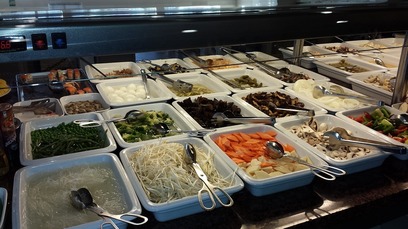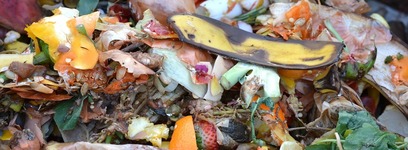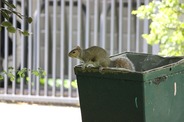August 2016
Food Digest is a quarterly newsletter written by inspectors from your local health department to support and educate Hennepin County food facility owners and managers about food safety as recommended by Minnesota Food Code 4626.
 Keep food protected from contamination
When food is being self-served or stored at an outdoor stand, it needs to be protected from contamination (in addition to the stand tent/roofing). This could include a dome shaped cover, lids for food containers, tin foil, plastic wrap, a sneeze guard, etc. This will help to prevent insects from landing on food and debris from falling in food. It also provides protection from coughing, sneezing, hair, etc.
Check out our short-term food license application for helpful guidelines and a self-inspection checklist.
We welcome comments or ideas about our newsletter.
Amy Zagar
612-543-5267
Hannah Marschinke
612-543-5255
|
 Farm field
 Large buffet
Individually licensed food establishments handle food through only a small piece of the greater food supply chain – typically at retail. However, food can potentially become contaminated at any stage of production from farm to table. It is for this reason that a retail establishment must obtain food from an approved source that uses approved methods. There are a few key aspects to verifying that food is unadulterated and approved for retail.
 Food is required to be labeled with an identification, including the contents/ingredients and the address where it was produced.
|
USDA meat stamps; Source: University of Minnesota-Extension

Meat must be inspected and stamped by the United States Department of Agriculture (USDA) or the Minnesota Department of Agriculture (MDA) Equal To program.
*State of Minnesota shaped stamp above is an MDA meat stamp; Source: University of Minnesota-Extension.
|
Traceability is also an important aspect of verifying products through the food supply chain using records such as lot numbers, dates, and invoices. This is particularly helpful in recall situations or epidemiological investigations. Product records should be kept concurrently with lots in inventory to maintain traceability. Food that is unlabeled or found to have an untraceable source must be rejected.
Verification of the food temperature upon receiving is an important step to ensuring
food that could be hazardous is safe to eat. This means refrigerated foods must arrive no warmer than 41°F and must
quickly be stored in mechanical refrigeration below 41°F. For exceptions to
this requirement, refer to the Minnesota Department of Health’s
fact sheet on receiving. The person assigned to this duty also needs to check for intact food
packaging and reject any food that has been adulterated. Note: because MN Rule 4626 specifically
indicates mechanical refrigeration, ice is not approved for cold storage:
4626.0395 3-501.16 POTENTIALLY HAZARDOUS FOOD; HOT AND COLD
HOLDING.*
Except during preparation, cooking, or cooling, or when time is
used as the public health control as specified in part 4626.0410, potentially
hazardous food shall be maintained:
A. at 60 degrees C (140 degrees F) or above, except that roasts
cooked to a temperature and for a time specified in part 4626.0340, item B, may be held at a
temperature of 54 degrees C (130 degrees F);
or
B. at 5 degrees C (41 degrees F) or below under mechanical
refrigeration, except as specified in part 4626.0405, item B.
Expiration Date? “Best Before” or “Use By” dates generally
refer to the best quality and are not safety dates, with the exception of
infant formula. If foods are mishandled foodborne bacteria can grow
and, if pathogens are present, cause foodborne illness. This can occur before or after the
date on the package. For example, if hot dogs are taken to a picnic and left
out several hours, they will not be safe if used thereafter, even if the date
hasn't expired. Date
marking in food establishments is required on all refrigerated potentially hazardous foods that will be
held for more than 24 hours. More information on date marking requirements can
be found on the Minnesota Department of Health's website.
 Food scraps
Waste not, want not. Food can also be lost or wasted at any stage of the food supply chain, though in North America it is more often lost at retail or consumption than in agriculture or distribution (FAO, 2011). Energy embedded in wasted food represents approximately 2.5% of annual energy consumption in the United States, so a reduction in waste will be energy saved. Food loss also contributes to excessive water consumption, pollution, and decreased biodiversity. Local programs in Minnesota, such as Hennepin County Organics Recycling, aim to separate energy-rich organics like food scraps from municipal waste streams. Coupled with reducing our consumption of single-use items, recycling and composting will lead to major fuel and energy savings.
The Tax Reform Act of 1976 has allowed tax deduction for the base cost plus half potential profits for food donated to charitable organizations. Since 1996, the Bill Emerson Good Samaritan Food Recovery Act has released liability from suppliers opting to donate food in an effort to redistribute and repurpose that which would otherwise be wasted. For more information on food waste reduction, check out the links below:
Environmental Protection Agency:
https://www.epa.gov/sustainable-management-food
National Restaurant Association Guide:
http://infohouse.p2ric.org/ref/12/11907.pdf
Food Waste Reduction Alliance:
http://www.foodwastealliance.org/full-width/
Metro Food Access Network:
https://sites.google.com/a/umn.edu/mfan/home
Back to top
 No one wants mice, rats or insects invading their
restaurant. When the weather is warm, however, these critters are out in full
swing. It’s an important time to remind all employees in the food establishment how to keep them out. The first step it to keep the outdoor trash, recycle and grease bin covers closed after
use.
Trash and recycling areas need to be cleaned often and free
of unnecessary debris
or clutter. Rodents and insects find cluttered trash areas ideal for shelter.
Usually the outdoor trash area is near the food establishment. If conditions are right, rodents and
insects may then travel to the source of the food through open doors, holes, or cracks in the building.
|
 Outdoor trash, recycle and grease bin lids need to be kept closed
In addition to keeping the lids closed and the trash area clean and clutter free, all receptacles must also be durable, cleanable and nonabsorbent. Check for holes in lids, rusted areas on the receptacle or other wear and tear to prevent trash leakage and places where rodents and insects can gain access.
Back to top

Remodeling or upgrading components of your food establishment? Maybe adding some new equipment? Many times these projects need to go through Hennepin County's plan review process. A plan review application can be found on our website.
If you are unsure if you need to apply for plan review, contact our office to speak to an inspector (612-543-5200).
Hennepin County Food Ordinance 3
Section 5: INSPECTIONS AND PLAN
REVIEW.
5.2 Plan Submission. The license applicant or
licensee shall submit properly prepared plans to the Health Authority under the
provisions of Minnesota Rules, Chapter 4626.1720. The plans, specifications,
application, and plan review fee shall be submitted to the Health Authority at
least 30 days before beginning construction or remodeling.
Back to top
Visit www.hennepin.us/envhealth for information on:
- General environmental health
- Basic food safety classes
- Temporary food stand licensing
- Food license information, categories, and fee schedule
- New construction or remodeling application
Radon information and test kits
www.hennepin.us/radon
Septic system requirements and
procedures
www.hennepin.us/septic
Body art licensing information
(tattooing and piercing)
www.hennepin.us/bodyart
Beaches in Hennepin County
www.hennepin.us/beaches
Back to top
Visit www.hennepin.us/envhealth to subscribe to our e-newsletter.
|